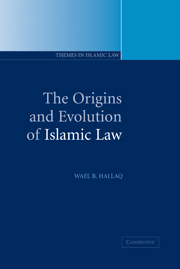Book contents
- Frontmatter
- Contents
- Maps
- Map 1 Arabia ca. 622 ad
- Map 2 Muslims lands in the third/ninth century
- Introduction
- 1 The pre-Islamic Near East, Muḥammad and Quranic law
- 2 The emergence of an Islamic legal ethic
- 3 The early judges, legal specialists and the search for religious authority
- 4 The judiciary coming of age
- 5 Prophetic authority and the modification of legal reasoning
- 6 Legal theory expounded
- 7 The formation of legal schools
- 8 Law and politics: caliphs, judges and jurists
- Conclusion
- Glossary of key terms
- Short biographies
- Bibliography
- Suggested further reading
- Index
1 - The pre-Islamic Near East, Muḥammad and Quranic law
Published online by Cambridge University Press: 05 June 2012
- Frontmatter
- Contents
- Maps
- Map 1 Arabia ca. 622 ad
- Map 2 Muslims lands in the third/ninth century
- Introduction
- 1 The pre-Islamic Near East, Muḥammad and Quranic law
- 2 The emergence of an Islamic legal ethic
- 3 The early judges, legal specialists and the search for religious authority
- 4 The judiciary coming of age
- 5 Prophetic authority and the modification of legal reasoning
- 6 Legal theory expounded
- 7 The formation of legal schools
- 8 Law and politics: caliphs, judges and jurists
- Conclusion
- Glossary of key terms
- Short biographies
- Bibliography
- Suggested further reading
- Index
Summary
THE GENERAL NEAR EASTERN BACKGROUND
It was in the Hejazi cities of Mecca and Yathrib – later renamed Medina – that a man called Muḥammad came forward to proclaim a new religion with a political order at its center. By the time of his death in 11/632, he had left behind a small state and clear notions of justice, but with underdeveloped ideas of law and an even less developed judiciary. Soon, however, Islam was to conquer lands east and west, ranging from western China to the Iberian peninsula. Along with this territorial expansion, the new religion generated a full-fledged, sophisticated law and legal system in the short span of the three-and-a-half centuries that followed its inception.
By the time of Muḥammad, Mecca and its northern neighbor Yathrib had known a long history of settlement and were largely a part of the cultural continuum that had dominated the Near East since the time of the Sumerians. True, the two cities were not direct participants in the empire cultures that prevailed elsewhere in the Near East, but they were tied to them in more ways than one. Prior to the Arab expansion in the name of Islam, Arabian society had developed the same types of institutions and forms of culture that were established in the imperial societies to the south and north, a development that would later facilitate the Arab conquest of this region.
- Type
- Chapter
- Information
- The Origins and Evolution of Islamic Law , pp. 8 - 28Publisher: Cambridge University PressPrint publication year: 2004



